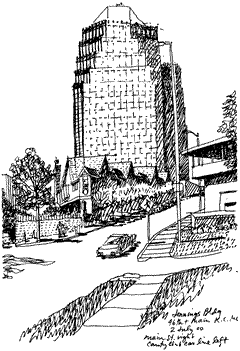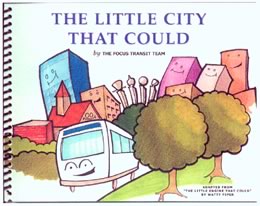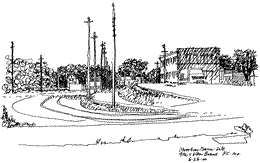
Architects help develop a comprehensive policy, now up for vote
 In
the beginning, we were a river town; then a rail town; then a cow town;
then a "city beautiful." Now we're a bustling. sprawled giant,
the capitol of the freeway. And through it all, it was transportation
policy and investment that guided Kansas City's growth. And we love it—look
what we have done as a regional community for the greatest symbol of our
love affair with transportation, Union Station's renovation!
In
the beginning, we were a river town; then a rail town; then a cow town;
then a "city beautiful." Now we're a bustling. sprawled giant,
the capitol of the freeway. And through it all, it was transportation
policy and investment that guided Kansas City's growth. And we love it—look
what we have done as a regional community for the greatest symbol of our
love affair with transportation, Union Station's renovation!
The development of our internal transportation system is a story in itself. We started with horse-drawn trams, eventually electrified them, and, by 1945, we were carrying some 136,000,000 passengers per year on one of the most extensive streetcar/trolley bus/bus systems in the country. Then it happened . . .
In our zeal to remedy substandard housing—and with the blessing and financing of federal highway initiative—we plowed new highways through our old city blocks and around our central business district. We embraced the automobile as the panacea of transportation and in the next 40 years leaked out across our countryside from a density of 5,600 per square mile in 1950 to a current density of less than 1,400 per square mile. Downtown looks like it was hit by a bomb.
The good news is, Kansas City is wending its way back to an urban-centered, comprehensive transportation policy that has been 30 years in the making.
A brief history
1971: Kansas City Area Transit
Authority (KCATA) acquires the remaining private transit operators.
 The
local AIA chapter publishes a promotional piece advocating renewed investment
in transit to stem road congestion, air pollution, fuel consumption, and
disinvestment in the urban center. This effort echoes suggestions in the
1971 Downtown Plan of the Land Clearance for Redevelopment Authority,
which assumed that the single-occupant-auto commuter ratio would drop
from 50 to 40 percent, and transit usage would rise to 30 percent of commuter
trips. (These assumptions have never come close to being realized.)
The
local AIA chapter publishes a promotional piece advocating renewed investment
in transit to stem road congestion, air pollution, fuel consumption, and
disinvestment in the urban center. This effort echoes suggestions in the
1971 Downtown Plan of the Land Clearance for Redevelopment Authority,
which assumed that the single-occupant-auto commuter ratio would drop
from 50 to 40 percent, and transit usage would rise to 30 percent of commuter
trips. (These assumptions have never come close to being realized.)
1975: The KCATA lays out a plan for 24 miles of fixed guideway transit as the backbone of their concept for improved transit service, beginning 25 years of planning toward a Kansas City Light Rail system.
1981: Planning had progressed to a recommended study of corridors for further study, generally radiating from downtown Kansas City, Mo. This was also the year that KCATA finally won the lawsuit over the ownership of the Country Club car line right-of-way.
1983: The Year of the Walnut Transit Mall plan (a concept that was successfully used on Denver's Sixteenth Street). After the miserable failure of the "mall" along Minnesota Avenue in Kansas City, Kans., there is massive opposition.
1987: The Grand-Main Plan showing light rail running north on Grand, looping around the City Market and returning south on Main Street. This plan served as a step toward involving the Federal Transit Administration in Kansas City's transit planning.
1989: Monorail system study, which established the cost of the monorail at some four to five times that of an at-grade light rail system. The study raised skepticism about extending such a costly system on a regional level, which consistently had been an objective in all this planning.
1992–1995: KCATA wins funding for the Major Investment Study (MIS) from the FTA and for the next three years undertakes the planning of a light rail system. The MIS ends with a "preferred alternative," which was estimated to cost $450,000,000 (in 1994 dollars) to build. The "starter phase," a single line, was estimated at $200,000,000.
 1993:
AIA/Kansas City undertakes development of a "comprehensive plan,"
the first since 1947. It was approved by the City Council in 1993 and
became FOCUS Kansas City. The plan developed into the most citizen-led
planning process ever conceived by humankind, eventually involved some
3,000 Kansas City residents and won the national Outstanding Planning
Award of the American Planning Association. One of the key facets of that
plan was an insistence on fixed guideway transit to:
1993:
AIA/Kansas City undertakes development of a "comprehensive plan,"
the first since 1947. It was approved by the City Council in 1993 and
became FOCUS Kansas City. The plan developed into the most citizen-led
planning process ever conceived by humankind, eventually involved some
3,000 Kansas City residents and won the national Outstanding Planning
Award of the American Planning Association. One of the key facets of that
plan was an insistence on fixed guideway transit to:
• Get people to and from work
• Reinvigorate the disinvested urban core
• Serve as a stimulant to the planning of more neighborly neighborhoods
in our undeveloped suburban areas.
The plan was an outgrowth of community activism practiced by Director Vicki Noteis, AIA. She picked up the shredded Preliminary Engineering plan, got approval of the KCATA Board and the city council to make it part of FOCUS Kansas City's implementation phase, and began the Central Business Corridor Transit Plan (CBCTP). This was a yearlong process of forging a citizen-led consensus on what kind of transportation system this community needs and will pay for.
Up for vote
The CBCTP was approved by the city council for an election this month,
and we are optimistic. In a public opinion study, the Greater Kansas City
Chamber of Commerce found that more than 70 percent of residents believe
transit improvement is an important investment now. Further, the newly
constituted citizen's transit lobby, the Regional Transit Alliance, now
boasts 600 members who include many important business and civic leaders.
Together with Mid America Regional Council, they have undertaken another
poll, which indicates that some 64 percent of Kansas City voters would
be "likely" to vote for the transit plan that has begun to emerge
from the CBCTP process. These polls, plus the success of the I-35 Commuter
Rail Plan (now in preliminary engineering) and the rejection of funding
for a further-out new beltway proposal suggest that people in the Kansas
City region have come to realize that our transportation policy of near-total
reliance on the automobile is inadequate in today's transportation and
urban development picture.
Kansas City's transportation future will not be a transit plan—it will be a comprehensive transportation policy that looks at the whole region and utilizes all modes of transportation in an appropriate mix: walking, biking, driving, taxis, paratransit, shuttles, buses, fixed guideway transit, and commuter rail. It will be a future that allows for choice in transportation modes, attracting "discretionary riders," who use transit by choice, and empowering those too young, old, or impaired to drive to reach the places they need to be. It will be a policy that relieves the stranglehold on parking, and brings action back to the center of our town.
Kite Singleton, FAIA, practices urban design and architecture in his eponymous firm in Kansas City. He was instrumental in initiating the FOCUS Kansas City Comprehensive Plan and has served as a consultant leader of the Central Business Corridor Transit plan.
Copyright 2001 The American Institute of Architects. All rights reserved.
![]()
|
|
|